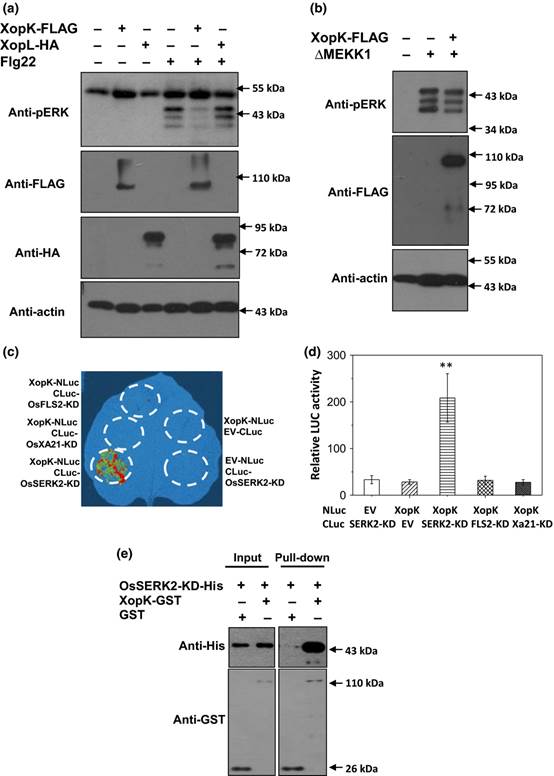微生物所发现水稻黄单胞菌效应子调控作物免疫新机制
来源:《新植物学家》
作者:秦君等
时间:2018-07-11

黄单胞菌是一类能够侵染水稻、小麦、番茄以及十字花科等多种单子叶和双子叶植物的病原细菌。水稻黄单胞菌侵染水稻造成的白叶枯病是水稻最主要的细菌性病害之一,给农业生产带来了巨大的损失。
病原细菌通过三型分泌系统分泌许多效应子进入植物细胞内,操控植物细胞内的免疫信号传导以及其他多种细胞生物学过程(如干扰植物蛋白功能、操纵植物激素改变等),来帮助病原微生物致病。水稻白叶枯病菌的三型分泌系统效应子包括两大类:转录激活子样(transcription activator-like/TAL)和非转录激活子样(non-TAL)效应子。TAL 效应子通过自身的重复序列直接识别并结合靶基因启动子来调控宿主基因表达;然而对 non-TAL 效应子致病机理的了解却十分匮乏。
中国科学院微生物研究所张杰课题组对水稻白叶枯病菌 16 个 non-TAL 效应子的功能进行了系统分析,分离了在水稻黄单胞菌致病性中发挥关键作用的效应子 XopK。研究发现 XopK 具有 E3 泛素连接酶活性,通过直接泛素化修饰水稻重要免疫受体激酶 OsSERK2 并介导其降解,抑制植物免疫反应从而促进病菌致病性。该研究揭示了水稻白叶枯病 non-TAL 效应子 XopK 的生化活性,阐明了其操控植物免疫的机理和在病菌致病过程中的功能。
该成果于 6 月 27 日在线发表于国际学术期刊 New Phytologist。该研究的水稻材料和田间接种试验与四川农业大学教授陈学伟团队合作。张杰课题组的助理研究员秦君和四川农业大学博士周晓钢为论文共同第一作者,张杰和陈学伟为共同通讯作者。此项研究得到了中科院战略性先导科技专项(B 类)、国家自然科学基金以及中科院青年创新促进会的资助。(来源:中国科学院微生物研究所)
The Xanthomonas effector XopK harbours E3 ubiquitin‐ligase activity that is required for virulence
Abstract
· Xanthomonas oryzae pv. oryzae is the causative agent of rice bacterial leaf blight. While the type III secretion system of X. oryzae pv. oryzae is essential for virulence, the biochemical activities and virulence mechanisms of non‐transcription activator‐like (non‐TAL) effectors delivered by this system are largely unknown.
· Here, by screening for non‐TAL effectors that contribute to X. oryzae pv. oryzae virulence, we revealed that Xanthomonas outer protein K (XopK) inhibits pathogen‐associated molecular pattern‐triggered immunity upstream of mitogen‐activated protein kinase cascades.
· Specifically, XopK interacted with and directly ubiquitinated rice somatic embryogenic receptor kinase 2 (OsSERK2), resulting in its degradation. Accordingly, mutation of a putative ubiquitin‐conjugation enzyme (E2) binding site abolished XopK‐induced degradation of OsSERK2 and compromised XopK‐dependent virulence.
· As crucial immune regulators associated with a multitude of immune receptors, SERKs have been shown to be perturbed by Pseudomonas effectors via different mechanisms. Our study revealed a distinct perturbation mechanism of SERK activity via ubiquitination achieved by Xanthomonas non‐TAL effector.
原文链接:https://nph.onlinelibrary.wiley.com/doi/epdf/10.1111/nph.15287




